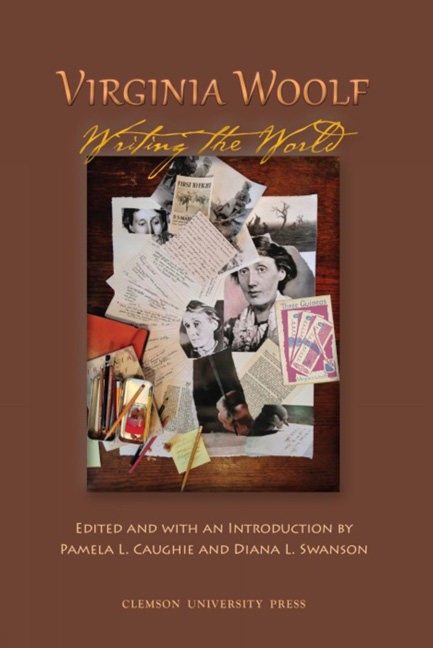Book contents
- Frontmatter
- Table of Contents
- Introduction
- Acknowledgmen
- Abbreviation
- WAR AND PEACE
- WORLD WRITER(S)
- ANIMAL AND NATURAL WORLD
- “And the donkey brays”: Donkeys at Work in Virginia Woolf
- Companion Creatures: “Dogmanity” in Three Guineas
- Virginia Woolf's Object-Oriented Ecology
- The Bodies In/Are The Waves
- Stretching our “Antennae”: Converging Worlds of the Seen and the Unseen in “Kew Gardens”
- “The Problem of Space”: Embodied Language and the Body in Nature in To the Lighthouse
- “Whose Woods These Are”: Virginia Woolf and the Primeval Forests of the Mind
- WRITING AND WORLDMAKING
- Notes on Contributors
- Conference Program
- Appendix: Virginia Woolf Conference Exhibit Items, Newberry Library
“And the donkey brays”: Donkeys at Work in Virginia Woolf
from ANIMAL AND NATURAL WORLD
- Frontmatter
- Table of Contents
- Introduction
- Acknowledgmen
- Abbreviation
- WAR AND PEACE
- WORLD WRITER(S)
- ANIMAL AND NATURAL WORLD
- “And the donkey brays”: Donkeys at Work in Virginia Woolf
- Companion Creatures: “Dogmanity” in Three Guineas
- Virginia Woolf's Object-Oriented Ecology
- The Bodies In/Are The Waves
- Stretching our “Antennae”: Converging Worlds of the Seen and the Unseen in “Kew Gardens”
- “The Problem of Space”: Embodied Language and the Body in Nature in To the Lighthouse
- “Whose Woods These Are”: Virginia Woolf and the Primeval Forests of the Mind
- WRITING AND WORLDMAKING
- Notes on Contributors
- Conference Program
- Appendix: Virginia Woolf Conference Exhibit Items, Newberry Library
Summary
In summer 2012, when Pamela Caughie and I were proofreading transcriptions of the essays to be included in Woolf Online, I noticed something peculiar. “What is it with Virginia Woolf and donkeys?” I asked. In seemingly every essay we encountered, there was a donkey. And once we started noticing them, they were everywhere. My inbox was soon brimful of emails from Pamela reporting new donkey sightings. Woolf may not have written a novel without one, to say nothing of the hundreds of references scattered throughout her letters, diaries, and essays. The question, once we were confronted with this wealth of examples, became what to do with them. So what is it with Virginia Woolf and donkeys?
In A Room of One's Own (1929), Woolf's narrator describes how receiving an income of five hundred pounds a year from her aunt relieved her of the burden of making her “living by cadging odd jobs from newspapers, by reporting a donkey show here or a wedding there” (37). Oddly, Woolf never quite seems to have left the donkey show behind. With the recent emergence of animal studies, scholars have examined her literary treatments of companion species such as dogs and horses, as well as reptiles, amphibians, and insects. No one, however, has yet given sustained attention to donkeys.
Like dogs and horses, donkeys are companion animals but with a diff erent connotation for human observers. We map a certain dignity and grace onto horses, while donkeys serve a traditionally comic function in literature. While the donkey is a figure of toil— particularly for Woolf—it is also a figure of fun. It bears both of these associations vividly in Between the Acts (1941), as I will explore in this paper. Like horses, donkeys faced increasing obsolescence as working animals in the modernist period, given the spread of automobiles and other motorized vehicles. Yet it is in their labor that they most often inhabit Woolf's imagination through hundreds of mentions in her writing in all genres. Woolf associates their work with the work of the writer—but generally the less significant, more difficult work, the work less facilitated by ease and inspiration.
- Type
- Chapter
- Information
- Virginia Woolf: Writing the World , pp. 136 - 140Publisher: Liverpool University PressPrint publication year: 2015

